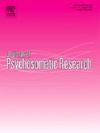用Whiteley指数评估癌症患者的健康焦虑。
IF 3.5
2区 医学
Q2 PSYCHIATRY
引用次数: 0
摘要
目的:健康焦虑(HA)常见于癌症等严重疾病患者。本研究旨在测试怀特利指数-7 (WI-7)测量血凝素的心理测量特性,并确定癌症患者血凝素升高的预后因素。方法:选取在德国某康复诊所接受治疗的1723例癌症患者,完成Whiteley指数-7、广泛性焦虑障碍筛查量表GAD-7、患者健康问卷PHQ-9、对进展的恐惧问卷top - q -12、对癌症复发的担忧问卷CARQ-4和EORTC QLQ-SURV100的两个子量表。结果:WI-7量表内部一致性较好(Cronbach’s α = 0.85),与其他量表的相关系数分别为:0.64 (GAD-7)、0.63 (PHQ-9)、0.75 (top - q -12)、0.71 (CARQ-4)、0.66 (SURV-HD)、0.75 (SURV-NHO)。女性的HA水平明显高于男性(效应值:d = 0.40), 60岁及以上患者的HA水平低于年轻患者(d = -0.32)。黑色素瘤患者HA平均评分最高(M = 10.9),接受抗体治疗的患者HA水平升高(M = 10.7)。当考虑年龄和性别时,肿瘤类型和治疗的影响比单变量分析的影响小。结论:WI-7是评价肿瘤患者血凝素的理想仪器。在评估癌症类型或治疗对血凝素的影响时,必须考虑到年龄和性别分布。年轻患者和女性在HA方面值得特别关注。本文章由计算机程序翻译,如有差异,请以英文原文为准。
Health anxiety in cancer patients, assessed with the Whiteley Index
Objective
Health anxiety (HA) is frequently observed in patients suffering from a severe disease such as cancer. This study aimed to test the psychometric properties of the Whiteley Index-7 (WI-7) measuring HA and to identify prognostic factors for heightened HA in cancer patients.
Methods
A sample of 1723 cancer patients, treated in a German rehabilitation clinic, completed the Whiteley Index-7, the Generalized Anxiety Disorder screener GAD-7, the Patient Health Questionnaire PHQ-9, the Fear of Progression questionnaire FoP-Q-12, the Concerns About Cancer Recurrence questionnaire CARQ-4, and two subscales of the EORTC QLQ-SURV100.
Results
The internal consistency of the WI-7 was good (Cronbach's α = 0.85), and the correlations between the WI-7 and other scales were as follows: 0.64 (GAD-7), 0.63 (PHQ-9), 0.75 (FoP-Q-12), 0.71 (CARQ-4), 0.66 (SURV-HD), and 0.75 (SURV-NHO). Women showed markedly higher levels of HA than men (effect size: d = 0.40), and patients aged 60 years and above reported lower levels of HA than younger patients (d = −0.32). Melanoma patients showed the highest HA mean score (M = 10.9), and patients receiving antibody therapy showed heightened levels of HA (M = 10.7). When considering age and sex, the effects of tumor type and treatment become smaller than in the univariate analyses.
Conclusion
The WI-7 is a suitable instrument for assessing HA in cancer patients. When evaluating the effects of cancer type or treatment on HA, one has to take into account the age and sex distribution. Younger patients and women deserve special attention regarding HA.
求助全文
通过发布文献求助,成功后即可免费获取论文全文。
去求助
来源期刊
CiteScore
7.40
自引率
6.40%
发文量
314
审稿时长
6.2 weeks
期刊介绍:
The Journal of Psychosomatic Research is a multidisciplinary research journal covering all aspects of the relationships between psychology and medicine. The scope is broad and ranges from basic human biological and psychological research to evaluations of treatment and services. Papers will normally be concerned with illness or patients rather than studies of healthy populations. Studies concerning special populations, such as the elderly and children and adolescents, are welcome. In addition to peer-reviewed original papers, the journal publishes editorials, reviews, and other papers related to the journal''s aims.

 求助内容:
求助内容: 应助结果提醒方式:
应助结果提醒方式:


